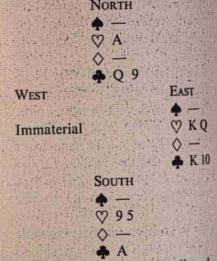Some little while ago, while I was dummy, one of our lady players passed a hand to me and said »
How do you play it in Six Spades?»
I did not really look at the hand and said, facetiously, » I think it might be made on a criss-cross squeeze.»
«Be serious- how would you play it?»
«On a criss-cross squeeze.»
«I’ve never heard of it- you’re pulling my leg.»
There certainly is such a play if you come and see me sometime, I’ll show you some criss crosses.
I found it difficult to explain then and I find it difficult now. Yet the criss-cross squeeze is not the rara avis people think. I am quite sure many have played it without knowing the name. Perhaps it will be best if I just give a simple example from actual play.

South deals and bids Spade; North, Two No Trumps; South, Four Spades. You may not like the bidding but the result is a game contract we would all like to be in. West leads a small diamond, East-wins with the Ace, returns a diamond and ruffs diamond.
East is now in some difficulty. To lead ![]() K looks dangerous, because if South has a doubleton and can discard one on
K looks dangerous, because if South has a doubleton and can discard one on ![]() Q, the heart Queen will be ruffed out. So, East exits with
Q, the heart Queen will be ruffed out. So, East exits with ![]() Q. Declarer wins with the Ace—crosses to dummy with
Q. Declarer wins with the Ace—crosses to dummy with ![]() J, cashes
J, cashes ![]() Q, discarding a small heart, and plays all his trumps. At the play of the last trump the position is:
Q, discarding a small heart, and plays all his trumps. At the play of the last trump the position is:

and East must make a discard. If he discards ![]() Q, declarer crosses to dummy with
Q, declarer crosses to dummy with ![]() A, returns to hand with
A, returns to hand with ![]() A, and cashes
A, and cashes ![]() 9. If he discards the
9. If he discards the ![]() 10, the club Ace is cashed—cross to dummy with
10, the club Ace is cashed—cross to dummy with ![]() A and cash
A and cash ![]() Q. Hence the name criss-cross squeeze.
Q. Hence the name criss-cross squeeze.
As you see, the play assumes the, missing high cards are in one hand, simply because there is no other way of making the contract. The beauty of it is, there is no deceptive play or guessing to be done just straightforward, minor mechanics to reach the end position and then it is automatic.
The declarer just cannot go wrong—the defender is a sitting duck and declarer lets him have both barrels and sits back smugly awaiting the » well play, partner dear»
Poor East—it seems he has no possible defense. Yet he has a weapon that is to his hand.
Look at the above hand again —they are really all the same. At some time the defender has to make what I call the critical discard—the discard that breaks up his defensive position. In this case it is at trick ten and it is this discard which gives away the whole show.
But why should he not make this critical discard one trick before it is due, so that his last four cards are ![]() KQ6 and
KQ6 and ![]() K-then at trick 10, which should he the critical discard, he throws
K-then at trick 10, which should he the critical discard, he throws ![]() Q.
Q.
Now review the position—declarer has an impossible guess. He crosses to dummy with ![]() A and now cannot recover.
A and now cannot recover.
The declarer who could not go wrong becomes someone who cannot go right and the sitting duck become a him of different colour: a rather expensive Champs Elysee type.
